
Just a few years ago, thermal imaging cameras fell into the “special interest” category. This means that, apart from the military and research, this technology was hardly ever used. But curiosity is growing among ordinary consumers as well. Whether it’s an energy evaluation of home insulation or a safety gadget for camping in the woods – for more and more people, a thermal imaging camera is also commonplace in everyday life. Our smartphone is the perfect interface. How thermal imaging camera and cell phone work together, want to show you in the following once.
Thermal imaging camera cell phone: areas of application
Some may ask the question, for what you should use a thermal imaging camera on the cell phone at all. Fields of application there are also far away from military and research meanwhile so some. It’s not just curiosity that plays a role here. There are also obvious applications for this technology in everyday life. For example, if you like to spend your weekends outdoors, camping in the thicket of the forest, a thermal imaging camera is a practical safety gadget. After all, even in total darkness, you can see if there is a wild boar or other creatures in your surroundings.
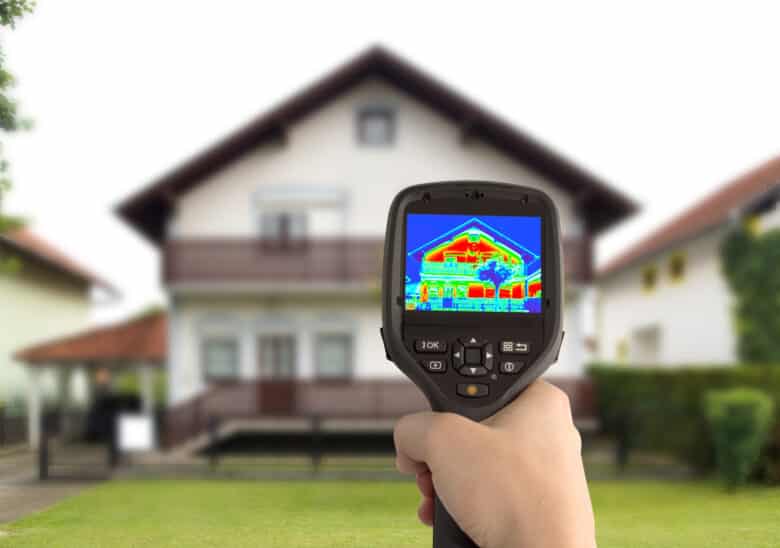
Further, the thermal imaging camera is a helpful gadget to initiate an individual energy saving plan. This is especially true for homeowners. After all, you can use the technology to find out how well your home is insulated. Is there a cold bridge somewhere or is the house a well-insulated building? Once you have identified the weak points, you can improve the insulation by replacing it. Last but not least, you can also check electronics. In particular with the own car this can come to use.
Heat imaging camera cell phone: Various options
An interaction of thermal imaging camera and cell phone is conceivable in two different ways. So there are external thermal imaging cameras that use your smartphone as a separate display. The advantage of these models is obvious. They are much more compact than full-fledged thermal imaging cameras. This not only makes them easier to transport. In addition, the frequent omission of an integrated display ensures a much lower price. Those who prefer an all-in-one solution will also find what they are looking for. There are now also customized outdoor smartphones that have an integrated thermal imaging camera. These are especially suitable for outdoor enthusiasts who have to pay attention to the scope of their transport goods during their excursions. Thus, such a smartphone is of course much more practical than a set consisting of a thermal imaging camera and a cell phone. Last but not least, there is also custom-made software that, so to speak, puts a filter on your regular smartphone camera, simulating a thermal imaging camera.
Separate thermal imaging camera
When using an external thermal imaging camera, manufacturers take advantage of your smartphone’s USB-C or Lightning port. Here, the small gadget is connected without further ado. The big advantage compared to the software solution is that no thermal image is simulated here. Instead, you supplement your smartphone’s existing technology with the necessary hardware, such as IR sensors and cameras. The devices then receive the necessary power supply via the port on the bottom. Most manufacturers also offer a customized app. With their help, you can then use far-reaching features such as temperature measurement of individual objects. Once you have finished using the thermal imaging feature, you can simply unplug the thermal imaging camera. This modular concept ensures that you get a compact smartphone that fits into small pockets when you remove the camera unit. Let’s take a look at three models.
InfiRay P2 Pro thermal imaging camera for mobile
The InfiRay P2 Pro promises a high-resolution thermal imaging experience with 256 x 192 pixels. The temperature range of 20°C to 600°C is also impressive. For example, you can specifically identify weak points in your house insulation. But you can also easily detect water leaks or other problems with the insulation of buildings and the corresponding electrical system. Not only photos are possible here. You can also record videos with a refresh rate of 25 Hz. This makes it easy to identify even moving targets. The whole thing is especially practical when you want to search your surroundings for animals outdoors, for example.

Operation is exceedingly simple thanks to plug-and-play. You simply connect the small camera to your smartphone via USB-C. Since it gets the necessary energy from the smartphone battery, you don’t have to charge a separate battery. Nothing stands in the way of using the compact camera on a construction site or in the forest thanks to its robust construction. The body is made entirely of metal, which promises high durability. The InfiRay P20 is available for both Android smartphones and iOS devices.



TOPDON thermal imaging camera for mobile
At first glance, TOPDON’s model may appear to have significant differences from InfiRay’s camera. In particular, the significantly larger housing of TOPDON may perhaps surprise one or the other a little. However, a look at the technical specifications reveals that both models are very similar. This already starts with the resolution. The resolution of this thermal imaging camera is also 256 x 192 pixels. The temperature range is also in a similar league. You can measure temperatures between -20°C and 550°C on objects. TOPDON’s main advantage is its accuracy. According to the manufacturer, you only have to reckon with deviations of up to 2°C during a measurement. That is a very good value!
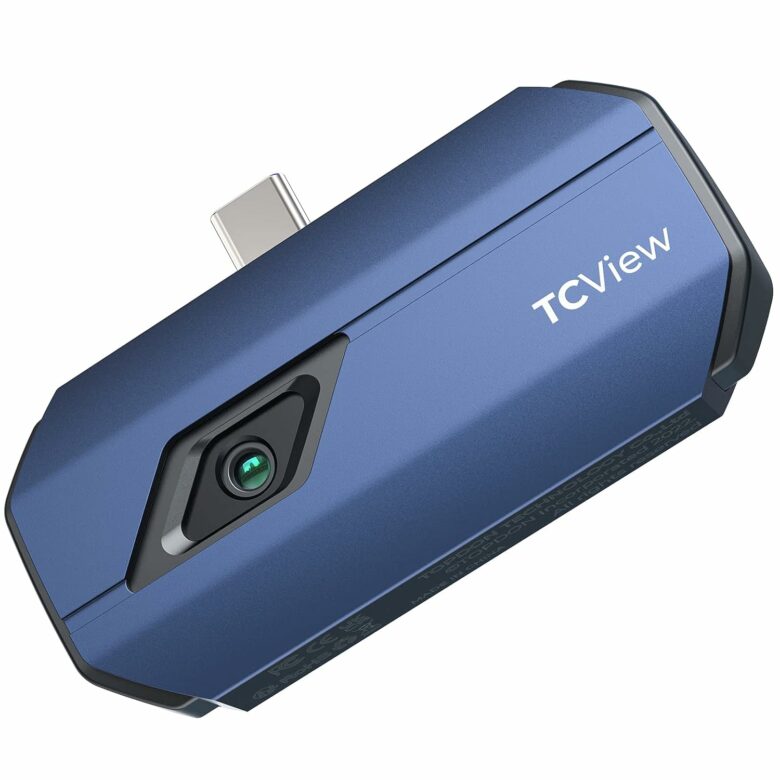
Furthermore, TOPDON’s model is very suitable for temperature monitoring of objects. Thus, the device creates a practical temperature diagram, where you can track the heat development of an object very well. In particular, regular overheating of electronic devices or temperature curves in your house insulation can be tracked very well this way. For a smartphone with a battery capacity of 3,000 to 5,000 mAh, the separate camera should be able to provide about 4 to 7 hours of operating time. Since you will rarely use the device for several hours at a stretch, this should certainly be completely sufficient for most users. You can also use TOPDON’s thermal imaging camera for both iOS and Android devices. The Android version is a few Euros cheaper.
FLIR ONE Gen 3 thermal imaging camera for mobile
The third external thermal imaging camera we want to introduce to you is the FLIR ONE Gen 3. As the name suggests, this is the third generation of this model by now. The manufacturer wants to make its portable thermal imaging camera even lighter and thinner. On top of that, the camera’s casing is supposed to be more robust, which is why you can look forward to a long service life. The basic construction of the camera is the same as its predecessors, even in its third generation. This means that you get a combination of a visible camera and a thermal imaging camera.
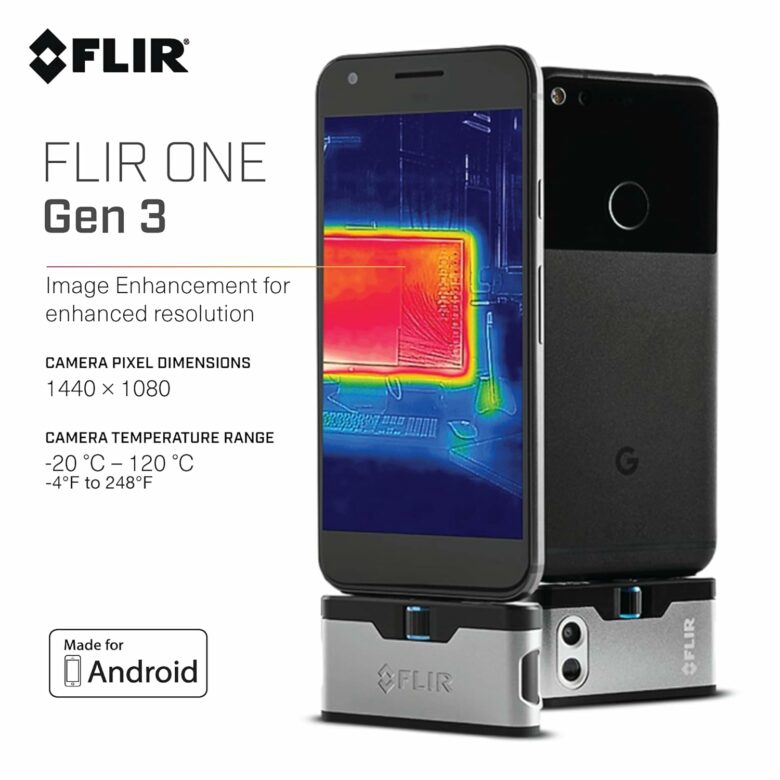
Here, the so-called MSX technology is used. By the way, the height connector, which is introduced in the third generation of the camera, is really practical. This is adjustable, which means that the camera harmonizes with pretty much every smartphone case. Previously, you always had to remove the case before you could use the camera. Of course, you can also take temperature measurements with the FLIR ONE Gen 3. This has several advantages in practice, which helps you in several areas of application. You can find weak points in your insulation or detect errors in the electronics of your car. Furthermore, you can keep a clear view even in total darkness.
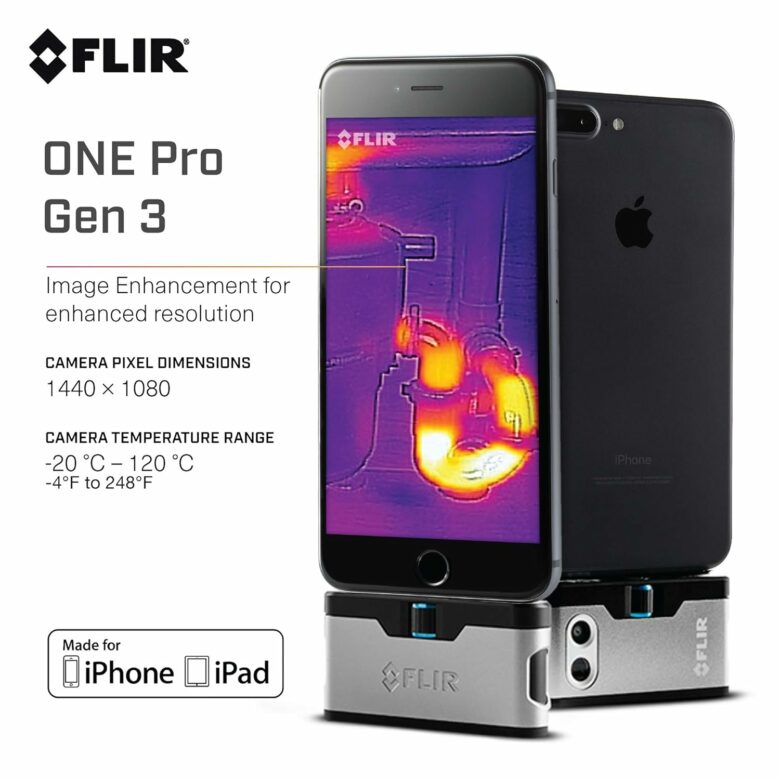
For example, it is easy to find the dog in your own backyard. A high level of user comfort is ensured by the interaction with the FLIR One APP available for iOS and Android OS. This is not only supposed to give you extensive tips and tricks when using the thermal imaging camera. On top of that, the manufacturer promises uncomplicated ways to share recordings via social media. The app also enables indirect use via smartwatch. For example, you should be able to film around the corner and keep an eye on everything on your smart watch. This camera is also available for both Android and iOS.

Outdoor smartphone with thermal imaging camera
There are advantages and disadvantages to opting for a separate thermal imaging camera that plugs into the smartphone’s charging port. Probably the biggest advantage is definitely the fact that you can use your smartphone as a conventional device far from thermal imaging. Since the technology for the thermal imaging camera is not permanently installed here, the smartphone also comes in the usual slim format. However, where there is light, there is also shadow. Accordingly, the use of separate thermal imaging cameras according to the above-mentioned concept also has decisive disadvantages. For one thing, it can always happen that you forget the camera when you go on a trip. The annoyance when unpacking the suitcase is then correspondingly large. A much bigger disadvantage, however, is the battery life.
The cameras you connect to your charging port draw their required power from the smartphone battery. Accordingly, the endurance of your smartphone is also significantly limited if you also have a thermal imaging camera connected. You cannot help yourself with a power bank either. After all, the port that could be used to charge the battery is occupied. This should be kept in mind by all those who use their thermal imaging camera not only from time to time, but on a regular basis. In this case, we advise you to buy a smartphone that already has a thermal imaging camera ex-factory. A prime example is the AGM G2 Guardian (test). As a true survival smartphone, it not only has a night vision camera, but also a thermal imaging camera.
This offers the features that you get when you plug in one of the thermal imaging cameras mentioned above. However, the key advantage is that you get an all-in-one solution. On top of that, the 7,000 mAh battery ensures an incredible staying power. The extensive technical equipment also promises a great performance. The heart of the device is a Qualcomm QCM6490. The display measures 6.58 inches and has a FHD+ resolution. A refresh rate of 120 Hz again promises buttery moving pictures. As an outdoor smartphone, it is waterproof, drop-proof and dust-proof according to the IP68, IP69K and MIL-STD-810H standards.

Heat imaging via software
Away from external thermal imager and all-in-one solution, there is still a low-budget solution. You can find it if you venture into the Google Play Store and Apple App Store. Here you can find numerous apps that make great promises in the field of thermal imaging. They are supposed to turn your conventional camera into a thermal imaging camera without further ado. In most cases, however, this is just cheap hocus pocus. This is simply because most smartphones are not capable of taking thermal images. They lack the necessary hardware in the form of an infrared sensor on the camera unit. Accordingly, the apps can only be dismissed as a small gimmick. With their help, you can only put a suitable filter on your pictures, which give the impression that it is a thermal image.
Conclusion: External camera or all-in-one solution?
Should you really want to have a full-fledged thermal imaging camera, it should be said that you should keep your hands off mere app solutions. These are nothing but a little gimmick and simply put a filter on your camera footage. Instead, you should opt for an external camera or an all-in-one solution in the form of an outdoor smartphone like the AGM G2 Guardian. What’s right for you depends on how often you plan to use the thermal imaging camera and what your smartphone needs are. If you only want to use it occasionally, you should only consider a suitable outdoor smartphone with a thermal imaging camera if you are looking for a robust phone for outdoor applications anyway. On the other hand, if you prefer a compact smartphone and only want to use the thermal imaging function from time to time, a separate plug-in thermal imaging camera is probably the more suitable solution.





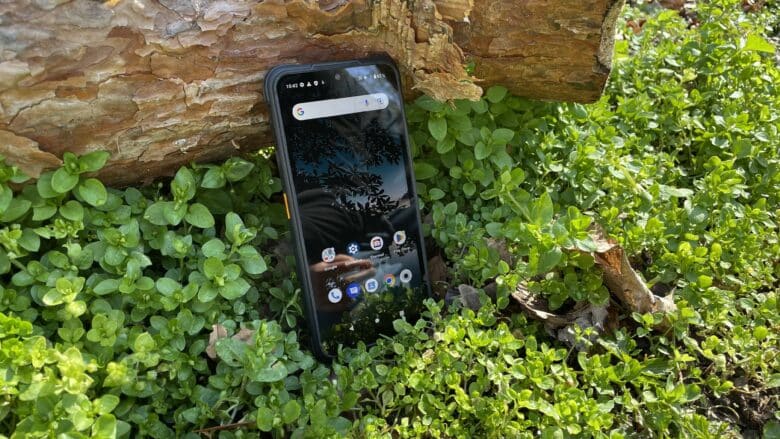





No replies yet
Neue Antworten laden...
Gehört zum Inventar
Beteilige dich an der Diskussion in der Basic Tutorials Community →